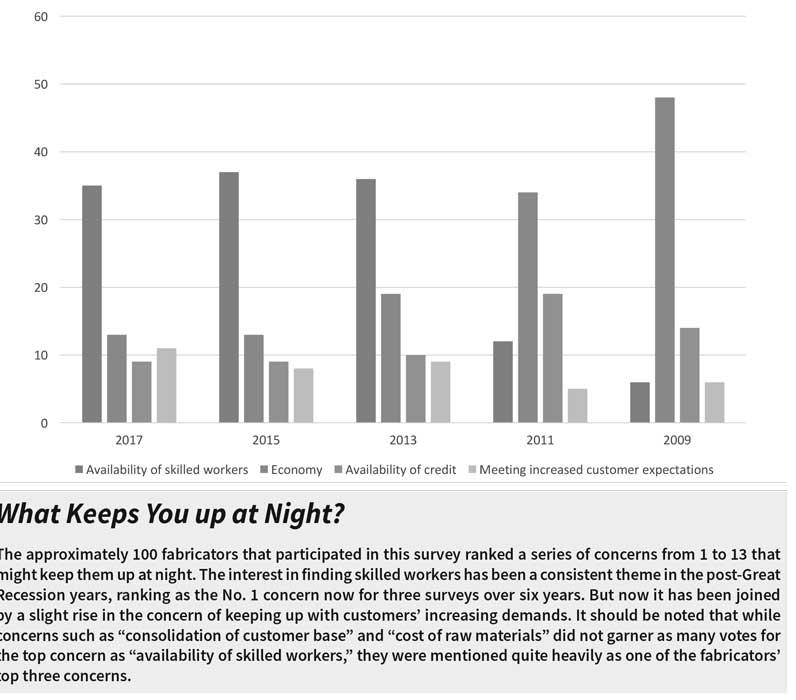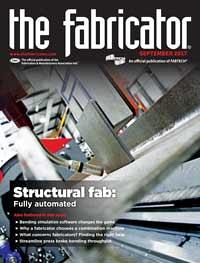Editor-in-Chief
- FMA
- The Fabricator
- FABTECH
- Canadian Metalworking
Categories
- Additive Manufacturing
- Aluminum Welding
- Arc Welding
- Assembly and Joining
- Automation and Robotics
- Bending and Forming
- Consumables
- Cutting and Weld Prep
- Electric Vehicles
- En Español
- Finishing
- Hydroforming
- Laser Cutting
- Laser Welding
- Machining
- Manufacturing Software
- Materials Handling
- Metals/Materials
- Oxyfuel Cutting
- Plasma Cutting
- Power Tools
- Punching and Other Holemaking
- Roll Forming
- Safety
- Sawing
- Shearing
- Shop Management
- Testing and Measuring
- Tube and Pipe Fabrication
- Tube and Pipe Production
- Waterjet Cutting
Industry Directory
Webcasts
Podcasts
FAB 40
Advertise
Subscribe
Account Login
Search
Finding the right help still a concern for fabricators
What keeps fabricators up at night? Trying to secure dependable talent with the right skills in the face of increased opportunities
- By Dan Davis
- September 14, 2017
- Article
- Shop Management
It’s amazing what a new presidential administration can do to energize the manufacturing community.
The unemployment rate stands at 4.3 percent, the lowest it’s been in 16 years, and total nonfarm payroll employment increased by 209,000 in July, even if employment numbers in the manufacturing sector didn’t change a whole lot from the previous month. Also in July, average hourly earnings of private-sector production and nonsupervisory employees increased by 6 cents to $22.10, which is good news given the stagnant nature of wages since the Great Recession. Metal fabricators apparently aren’t losing any sleep about President Donald Trump’s plans for the economy.
In fact, according to The FABRICATOR’s 2017 “What Keeps You up at Night?” survey, half of the fabricators surveyed believe that elected officials in the nation’s capital are finally listening to the needs of manufacturers. That’s a significant jump from the roughly 18 percent that felt the same way in 2015. That percentage was even lower according to 2013 and 2011 surveys.
So what’s the No. 1 concern for metal fabricators? It’s a refrain that has been heard consistently the last five times this survey has been done. Fabricators are concerned about the availability of skilled workers. This becomes a larger concern if fabricators are faced with an opportunity to take on more business, but struggle to do so because they can’t find the right workers. Fifty-six percent of the fabricators surveyed said that their businesses will be growing in 2017.
Concerned about finding skilled workers, fabricators are vocal in what they would like governmental agencies to do:
- “Emphasis on skill-based trades to kids in high schools."
- “Have more relevant contract training programs that can be done on-site and that align with workforce needs.”
- “We need a fundamental change in national education policy to focus on STEM courses and flow that down to vocational education.”
- “Better schools and better career training in high schools.”
- “Encourage industries to aggressively start apprenticeship programs.”
- “Return shop classes to high schools so kids have an introduction to potential manufacturing careers.”
Of course, refrains such as “Drain the swamp!” and “Repeal Obamacare!” were also part of the open-ended responses from fabricators. But the large majority of them wanted to see a brighter future for their chosen profession.
It should come as no surprise then that fabricators are taking matters into their own hands. Fifty percent of respondents indicated that their No. 1 focus in the area of human resources and workforce development is finding and retaining skilled labor. Another 24 percent plan to devote a majority of their efforts to establishing and offering apprenticeships or internships, which can be a major undertaking for small job shops. These responses don’t differ too much from the 2015 “What Keeps You up at Night?” survey.
A knee-jerk assessment of these trends might suggest that these shops are turning to automation to make up for the inability to find the right employees. However, only 23 percent indicated that they would devote major resources to automation in the next three to five years; in 2015, 32 percent of the fabricators surveyed were committed to more automation. Meanwhile, 21 percent and 17 percent revealed more focus being put on cost reduction and safety, respectively, over the next five years. That’s a major jump when compared to percentages from the 2015 survey. Fabricators have shifted attention in new directions as they obviously have made some changes to their production operations.
Trying to stay on top of opportunities and meeting customer demands are driving a lot of fabricators’ decision-making. That’s all right by them for the most part. According to the Fabricators & Manufacturers Association’s “Forming & Fabricating Job Shop Consumption Report” (FFJSCR) for the second quarter of 2017, 53.7 percent express optimism for the future business outlook, with around 35.3 percent expressing confidence that there would be stability. In the first-quarter FFJSCR, 61.9 percent were optimistic and 34.3 percent expressed confidence in stability. The change that has many worried is that last quarter only 3.7 percent had a pessimistic outlook and now that number is 10.9 percent—more than double.
For now fabricators don’t appear to be losing too much sleep about what’s going on in the general economy. That is always subject to change, however. The new administration may be more business-friendly, but it’s not exactly predictable in how it approaches its many reforms.
About the Author

Dan Davis
2135 Point Blvd.
Elgin, IL 60123
815-227-8281
Dan Davis is editor-in-chief of The Fabricator, the industry's most widely circulated metal fabricating magazine, and its sister publications, The Tube & Pipe Journal and The Welder. He has been with the publications since April 2002.
subscribe now

The Fabricator is North America's leading magazine for the metal forming and fabricating industry. The magazine delivers the news, technical articles, and case histories that enable fabricators to do their jobs more efficiently. The Fabricator has served the industry since 1970.
start your free subscription- Stay connected from anywhere

Easily access valuable industry resources now with full access to the digital edition of The Fabricator.

Easily access valuable industry resources now with full access to the digital edition of The Welder.

Easily access valuable industry resources now with full access to the digital edition of The Tube and Pipe Journal.
- Podcasting
- Podcast:
- The Fabricator Podcast
- Published:
- 04/16/2024
- Running Time:
- 63:29
In this episode of The Fabricator Podcast, Caleb Chamberlain, co-founder and CEO of OSH Cut, discusses his company’s...
- Trending Articles
AI, machine learning, and the future of metal fabrication

Employee ownership: The best way to ensure engagement

Steel industry reacts to Nucor’s new weekly published HRC price

How to set a press brake backgauge manually

Capturing, recording equipment inspection data for FMEA

- Industry Events
16th Annual Safety Conference
- April 30 - May 1, 2024
- Elgin,
Pipe and Tube Conference
- May 21 - 22, 2024
- Omaha, NE
World-Class Roll Forming Workshop
- June 5 - 6, 2024
- Louisville, KY
Advanced Laser Application Workshop
- June 25 - 27, 2024
- Novi, MI




























